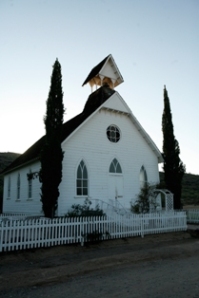Plans for a living history museum formulated in 1956 at a meeting where the Pioneer Arizona Foundation was formed. The museum was to be patterned after exhibits such as Williamsburg. Original plans called for an exhibition of life in Territorial Arizona, focusing a period from the 1870’s through the 1890’s. In 1962, Mr. and Mrs. Robert Lockett donated a state land lease to the museum. Plans were expanded to represent the history of Arizona, from the time of the Spanish Conquistadores to the achievement of statehood in 1912. Many notable Arizonans, including Governor Paul Fannin, United States Senators Barry Goldwater and Carl Hayden, Secretary of State Wesley Bolin and George Babbitt, Jr., were involved in the early planning. The official grand opening of Pioneer Arizona Living History Museum was celebrated on February 15, 1969. The village houses thirty historic buildings from the 1880s to the turn of the century.
The National Audubon Society provided plans for a nature center, and the first National Audubon Trail at the museum. The Arizona National Guard moved historical buildings and Seabees reservists delivered donated train tracks and mine ore cars. The Washington and the Phoenix Woman’s Clubs provided fund-raising for the refurbishing of the Northern Home, the School, and the Teacherage. The Neighborhood Youth Corps assembled buildings using historically accurate construction techniques and tools.
The original Ashurst Cabin is the 1878 boyhood home of Senator Henry Fountain Ashurst, Arizona’s first senator. He gained national fame as the “Silver-tongued Orator of Congress.” Born in Nevada, the future senator came to Arizona at the age of four. The family lived one mile east of Ashurst Lake in a box canyon. The father was a wild horse trapper and sheep rancher. Mrs. Ashurst gave birth to two children in this building. Cooking was done in the fireplace or over an outside campfire. The Ashurst cabin was moved, piece by piece, via a 200-foot steel cable tramway.
The Bakery was started by Edward Eisele, a German, who arrived in Arizona as a cook for a team surveying the Arizona Canal. He was employed at the Phoenix Bakery in 1881, and three years later, bought the business for $300. That year the bakery produced two hundred loaves of bread a day. As customers increased, the need for timely delivery of product was met when the bakery introduced a horse-drawn delivery wagon. In 1910, the Phoenix Bakery became the first in the territory to use a horseless carriage to distribute their wares.
The Teacherage, an original building, was a progressive concept for the 1880’s, when the community in Pleasant Valley, dedicated a cabin as a home for their teacher. Parsonages were built to attract ministers but exceptional for teachers. By 1910, teacherages relieved local families of boarding the teachers in their homes. Out of their earnings, teachers had to pay as much as thirty per cent of their salary for room and board to parents.
The Fort Woods exhibit shows how life was like for the pioneer military. The exhibit used two original buildings to reflect the original Fort McDowell. Fort Woods, the name chosen for this reconstructed fort, honors honor Sergeant Brent Woods, a Buffalo Soldier who was awarded the Medal of Honor for bravery during the Battle of Gavilan Canyon in New Mexico Territory on August 19, 1881. Re-enactors come from all over to stage battles and skirmishes from the Civil War, and the Spanish-American War. These are but a few of the buildings that ask travelers, “Why just read about history when you can live it?
Pioneer Living History Museum
3901 West Pioneer Road
Phoenix, Arizona 85086
Tel: (623) 465-1052
Fax: (623) 465-0683
Web Site: www.pioneeraz.org
Tags: Arizona Museums, History, living history, Phoenix Museums

December 1, 2012 at 4:21 am |
Fantastic blog! Do you have any helpful hints for aspiring writers?
I’m planning to start my own blog soon but I’m a little lost on everything.
Would you suggest starting with a free platform like WordPress or go for a paid option?
There are so many choices out there that I’m totally confused .. Any ideas? Thanks!
December 2, 2012 at 6:33 pm |
I like the free wordpress